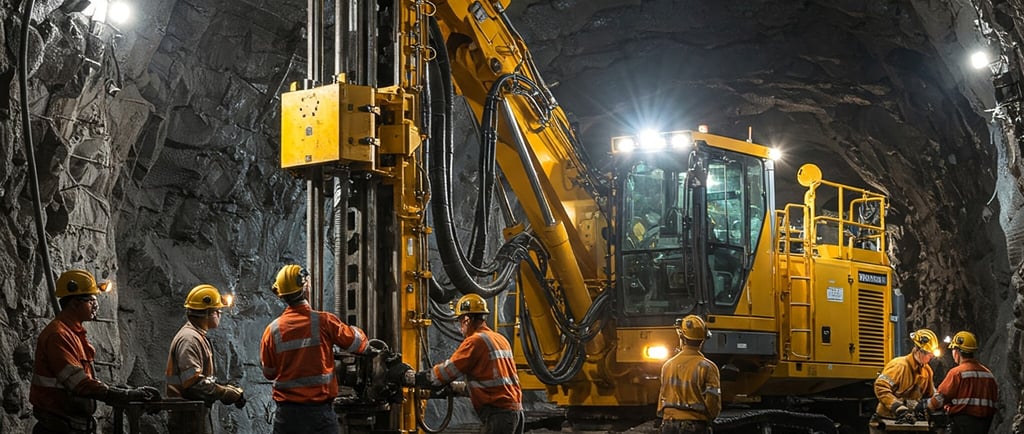Dig Deeper - Why safety in Mining Industry is non-negotiable?
Mining industries are running more than 100 years or more at all countries s for their economic growth. However, safety and health aspects of workers is still required to be improved in order to prevent serious injuries or fatality.
Ganpat Shinde
4/22/20252 min read


The mining industry is the backbone of many economies, supplying essential raw materials that power infrastructure, technology, and industry. But behind every ton of coal, every ounce of gold, and every rare earth metal, there are thousands of workers facing some of the most hazardous conditions imaginable. That’s why safety in mining isn’t just a regulation—it’s a responsibility.
The Hidden Dangers Below
Mining involves working with heavy machinery, handling explosive materials, and operating in dark, confined, and unstable environments. Common risks include:
Cave-ins and rockfalls - Unstable ground and falling rocks pose serious risks, especially in underground mines.
Explosions - Caused by the gases like Methane, dust or the use of explosives.
Exposure to harmful dust - Dusts, fumes, and gases e.g.- Silica dust, coal dust can lead to lung diseases.
Heavy Machinery accidents - Collisions, rollovers or equipment failures can cause injury or death.
Noise induced Hearing Loss - Prolonged exposure to loud machinery and blasting.
Fire and Heat Stress - Hot work environment or equipment malfunctions can cause burns or heat stroke.
Chemical Hazards - Exposure to toxic chemicals like cyanide, mercury or acids.
Confined Spaces - Risk of suffocation, poisoning or entrapment.
Electrical Hazards - Faulty wiring, equipment or water exposure can cause shocks or electrocution.
Ergonomic Hazards - Repetitive strain, poor posture or manual handling of heavy loads.
These are not just hypothetical dangers—they’re real, recurring threats that have led to major tragedies in mining history.
Modern Safety Measures That Save Lives
Thanks to evolving technology and stricter regulations, the mining industry has made significant strides in safety. Here are some key safety measures in use today:
Personal Protective Equipment (PPE): Helmets, respirators, visibility vests, and hearing protection are now standard.
Monitoring Technology: Real-time gas detection systems, geotechnical monitoring, and wearable health trackers help spot issues before they escalate.
Dust Suppression - Use water sprays, dust collectors and enclosed cabins.
Training & Education: Regular safety drills, hazard identification and equipment operation training empower workers to act safely and confidently.
Automation & Remote Operations: Robots and drones are being used to inspect dangerous areas, reducing human exposure.
Ground Support Systems - Use rock bolts, wire mesh and shotcrete in underground mines.
Ventilation Systems - Adequate air flow to dilute and remove toxic gases and dust.
Regular Equipment Maintenance - Prevent failures and reduce the risk of accidents.
Safe Work Procedures - Standard Operating Procedures (SOPs) for blasting, equipment use and emergencies.
Emergency Response Plan - Drills and accessible rescue equipment for fires, collapse or gas leaks.
Safety Culture: Perhaps most importantly, promoting a workplace culture where safety is valued and every voice is heard makes a big difference.
The Role of Leadership
Mining companies must take the lead by enforcing strict safety policies and holding every level of staff accountable. This includes:
Investing in safety innovations
Conducting regular inspections and audits
Encouraging workers to report unsafe conditions without fear
Leadership must walk the talk—when safety is prioritized from the top down, it filters into every shift, every crew and every decision.
Looking Ahead
The future of mining safety lies in smart technology, stronger regulations and above all, a commitment to human life. With the right balance of innovation and responsibility, the industry can continue to grow while protecting the people who keep it running.
Final Thoughts
In mining, safety isn't just about compliance—it's about care. It's about sending every worker home to their families at the end of the day. As we dig deeper into the earth, we must also dig deeper into our commitment to safety. Because in this industry, lives depend on it.
